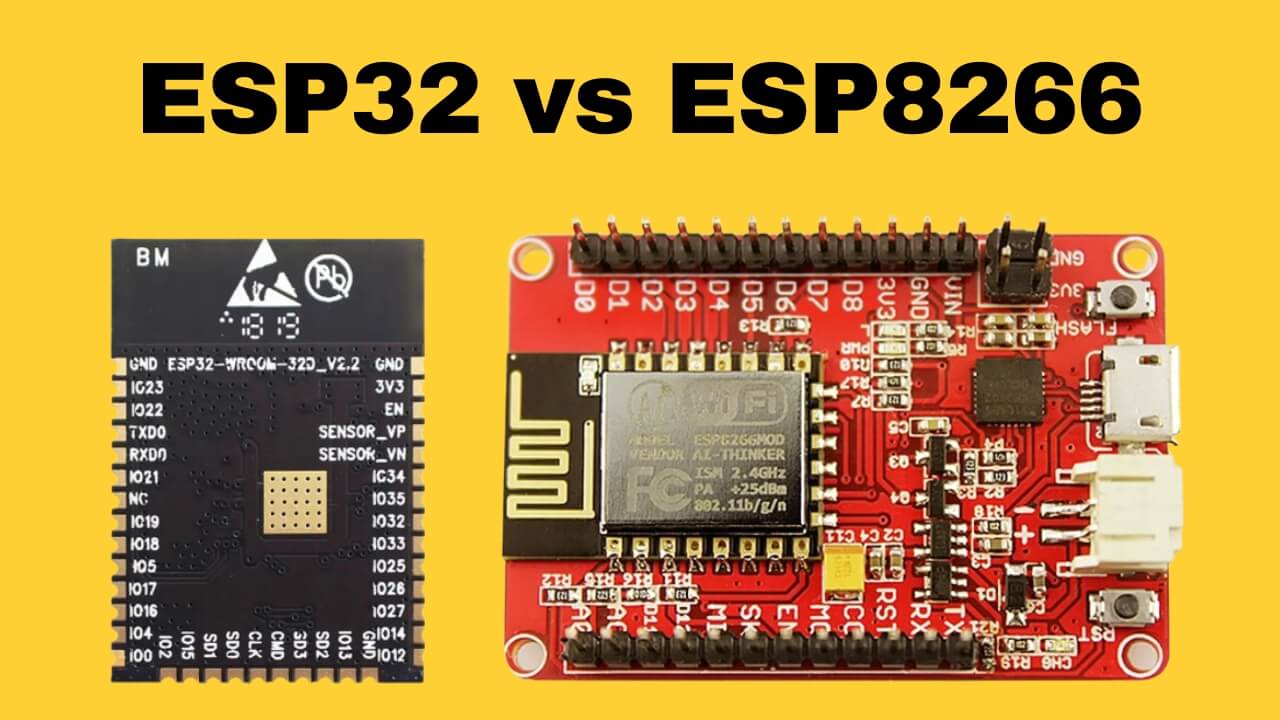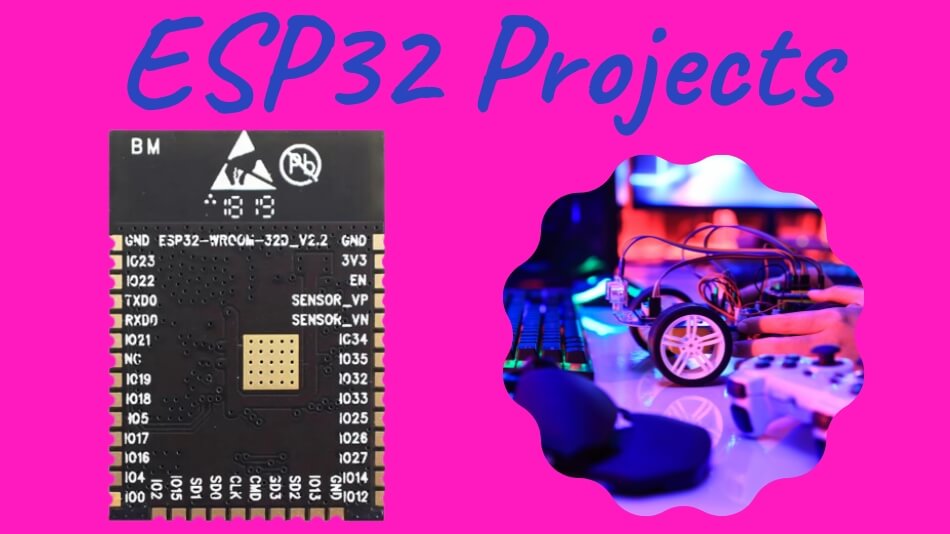Introduction

In the dynamic world of microcontrollers, the ESP32 and ESP8266 have emerged as popular choices for hobbyists and professionals. This comprehensive guide will explore the strengths and weaknesses of ESP32 vs ESP8266, offering insights to help you choose the best microcontroller for your needs.
Understanding ESP32 and ESP8266
What is ESP32?
- Definition and Features

- ESP32 is a series of low-cost, low-power microcontroller chips with integrated Wi-Fi and dual-mode Bluetooth.
- Key features include powerful CPUs, larger memory, and diverse peripheral interfaces.
What is ESP8266?
- Definition and Features
- The ESP8266 is a low-cost Wi-Fi microchip with a full TCP/IP stack and microcontroller capability.
- It is known for its small form factor, affordability, and ease of integration into various projects.
ESP32 vs ESP8266: Feature Comparison
Computing Power
- ESP32:
- Dual-core processor, higher clock speed.
- Suitable for more complex applications.
- ESP8266:
- Single-core processor, lower clock speed.
- Ideal for simpler, less demanding tasks.
Connectivity Options
- ESP32:
- Offers Wi-Fi and Bluetooth connectivity.
- Enhanced options for IoT projects.
- ESP8266:
- Primarily Wi-Fi connectivity.
- Limited to projects that don’t require Bluetooth.
Memory and Storage
- ESP32:
- Greater RAM and flash memory.
- Supports larger applications and more data storage.
- ESP8266:
- Less RAM and flash memory.
- Suitable for smaller applications.
Power Consumption
- ESP32:
- Higher power consumption due to more features.
- Requires efficient power management for battery-operated devices.
- ESP8266:
- Lower power consumption.
- Advantageous for energy-efficient projects.
Price Comparison
- Affordability:
- ESP8266 typically has a lower price point.
- ESP32 is slightly more expensive, reflecting its enhanced capabilities.
Ecosystem and Community Support
- ESP32:
- Robust community support.
- Wide range of libraries and development tools.
- ESP8266:
- Established a community with ample resources.
- Slightly less extensive than ESP32’s ecosystem.
Choosing the Right Microcontroller for Your Project
Application-Specific Considerations
- Complexity of the Project:
- ESP32 for advanced, feature-rich applications.
- ESP8266 for basic, Wi-Fi-centric tasks.
Developer Experience and Resources
- Ease of Use:
- Both offer user-friendly development environments.
- Consider your familiarity with each platform.
Long-Term Project Goals
- Scalability and Future-Proofing:
- ESP32 for projects that may evolve over time.
- ESP8266 for stable, well-defined applications.
Advanced Features: Delving Deeper into ESP32 vs ESP8266
Specialized Capabilities
- ESP32:
- Advanced security features like secure boot and flash encryption.
- Integrated sensors such as a hall effect sensor and temperature sensor.
- ESP8266:
- Limited to basic I/O and networking features.
- Lacks the integrated sensors and security features of ESP32.
Development Environment and Programming
- Tools and IDE Support:
- ESP32 and ESP8266 are supported by popular IDEs like Arduino IDE and PlatformIO.
- ESP32 enjoys additional support from the ESP-IDF framework, offering more advanced tools and features.
Community and Learning Resources
- Online Resources and Tutorials:
- A wealth of tutorials, forums, and documentation is available for both platforms.
- ESP32’s newer technology means more contemporary resources are available.
Real-World Applications: ESP32 vs ESP8266 in Action
Ideal Use Cases for ESP32
- Complex IoT Projects:
- Home automation systems require multiple sensor types.
- Advanced wearable devices with Bluetooth connectivity.
Ideal Use Cases for ESP8266
- Simple IoT Solutions:
- Basic home monitoring systems using Wi-Fi.
- Simple DIY projects like weather stations or Wi-Fi-controlled lights.
Future-Proofing Your Projects
The Evolution of Microcontrollers
- ESP32:
- Continuously evolving with new variants offering enhanced capabilities.
- A safer bet for projects that need to adapt to future technology trends.
- ESP8266:
- Although mature and stable, it may need to meet rapidly advancing tech requirements.
- Ideal for projects with a defined scope and limited need for future expansion.
Final Thoughts: Balancing Needs and Budget
When comparing ESP32 vs ESP8266, it’s essential to weigh your project’s technical needs against budget constraints. The ESP32, with its advanced features and capabilities, is undoubtedly the most powerful choice. However, for simple projects or when working within a tight budget, the ESP8266 still holds its ground as a reliable and cost-effective option.
Frequently Asked Questions
Q1: Is ESP32 better than ESP8266?
A: The term “better” is subjective and depends on your project requirements. ESP32 offers more power, memory, and additional features like Bluetooth and advanced security, making it suitable for complex applications. ESP8266, on the other hand, is ideal for more straightforward projects and is more cost-effective.
Q2: Can ESP8266 and ESP32 be used interchangeably?
A: While there are some commonalities, they are only partially interchangeable. ESP32 has more processing power, memory, and additional features that ESP8266 lacks. For basic projects that don’t require these extra features, ESP8266 might suffice, but for more advanced needs, ESP32 is necessary.
Q3: Is ESP32 suitable for beginners?
A: Yes, ESP32 is beginner-friendly. It is supported by a robust community and plenty of learning resources. Its versatility allows beginners to start with basic projects and gradually move to more complex ones.
Q4: How significant is the price difference between ESP32 and ESP8266?
A: The price difference varies but is generally small. The ESP8266 is less expensive and offers excellent value for more straightforward projects. The ESP32, while slightly more expensive, provides a broader range of features and capabilities, making it a worthwhile investment for more advanced projects.
Conclusion
In the showdown of ESP32 vs ESP8266, the choice boils down to your project’s specific needs and complexity. The ESP32 stands out with its dual-core processor, more significant memory, Bluetooth capability, and advanced security features, catering to complex and evolving projects.
On the other hand, the ESP8266 is a reliable, cost-effective solution for more straightforward, Wi-Fi-centric applications.
Both microcontrollers offer strong community support and are accessible to beginners, making them excellent choices in their respective niches.
Ultimately, your decision should align with your project’s requirements, budget, and long-term goals. Whether you choose the powerful ESP32 or the efficient ESP8266, both microcontrollers open a world of possibilities for hobbyists and professionals alike in IoT and beyond.

